2016 AP Micro FRQ- Consumer Choice PDF

| Title | 2016 AP Micro FRQ- Consumer Choice |
|---|---|
| Course | Economics |
| Institution | University of Pretoria |
| Pages | 2 |
| File Size | 133.5 KB |
| File Type | |
| Total Downloads | 52 |
| Total Views | 154 |
Summary
Download 2016 AP Micro FRQ- Consumer Choice PDF
Description
2. Martha has a fixed budget of $20, and she spends it all on two goods, X and Y. The price of X is $4 per unit, and the price of Y is $2 per unit. The table below shows the total benefit, measured in dollars, Martha receives from the consumption of each good. Quantity of X
Total Benefit from X
Quantity of Y
Total Benefit from Y
0
$0
0
$0
1
$16
1
$10
2
$28
2
$18
3
$36
3
$24
4
$40
4
$28
5
$41
5
$30
(a) What is Martha’s marginal benefit of the fifth unit of good X? (b) Calculate the total consumer surplus if Martha consumes 5 units of X. Show your work. (c) Martha is currently consuming 4 units of X and 2 units of Y. Use marginal analysis to explain why this combination is not optimal for Martha. (d) What is Martha’s optimal combination of goods X and Y? (e) Indicate whether each of the following will cause the optimal quantity of good Y to increase, decrease, or stay the same. (i) The price of good Y doubles. (ii) Martha’s income falls to $10 with no changes in prices. (iii) Martha’s income doubles, and the price of both goods double.
© 2016 The College Board. Visit the College Board on the Web: www.collegeboard.org.
GO ON TO THE NEXT PAGE. -3-
AP® MICROECONOMICS 2016 SCORING GUIDELINES Question 2 7 points (1+1+1+1+3) (a) 1 point: • One point is earned for stating that the marginal benefit is $1. (b) 1 point: • One point is earned for correctly calculating the total consumer surplus from consuming 5 units of X. CS = ($16 − $4) + ($12 − $4) + ($8 − $4) + ($4 − $4) + ($1− $4) = $21 OR CS = $41− $20 = $21 (c) 1 point: • One point is earned for explaining that this combination of X and Y is not optimal because the marginal benefit per dollar of good X (MBx/Px=$4/$4 =1) is less than the marginal benefit per dollar of good Y (MBy/Py=$8/$2=4). (This can also be stated as MBx/MBy< Px/Py.) (MBx/Px = 1) is not equal to (MBy/Py = 4) is acceptable. MBx/Px is less than MBy/Py is acceptable. MBy/Py is greater than MBx/Px is acceptable. (d) 1 point: • One point is earned for stating that Martha’s optimal combination is 3 units of X and 4 units of Y. (e) 3 points: • One point is earned for stating that the optimal quantity of good Y will decrease. • One point is earned for stating that the optimal quantity of good Y will decrease. • One point is earned for stating that the optimal quantity of good Y will stay the same.
© 2016 The College Board. Visit the College Board on the Web: www.collegeboard.org....
Similar Free PDFs

FRQ for AP test
- 18 Pages

AP Psych FRQ
- 1 Pages

Ap multiple choice - AP Calculus
- 243 Pages

Ap MIcro 2018 Free response
- 4 Pages

Ap lang multiple choice practice
- 19 Pages

Ap13 frq comp sci frq a
- 20 Pages
Popular Institutions
- Tinajero National High School - Annex
- Politeknik Caltex Riau
- Yokohama City University
- SGT University
- University of Al-Qadisiyah
- Divine Word College of Vigan
- Techniek College Rotterdam
- Universidade de Santiago
- Universiti Teknologi MARA Cawangan Johor Kampus Pasir Gudang
- Poltekkes Kemenkes Yogyakarta
- Baguio City National High School
- Colegio san marcos
- preparatoria uno
- Centro de Bachillerato Tecnológico Industrial y de Servicios No. 107
- Dalian Maritime University
- Quang Trung Secondary School
- Colegio Tecnológico en Informática
- Corporación Regional de Educación Superior
- Grupo CEDVA
- Dar Al Uloom University
- Centro de Estudios Preuniversitarios de la Universidad Nacional de Ingeniería
- 上智大学
- Aakash International School, Nuna Majara
- San Felipe Neri Catholic School
- Kang Chiao International School - New Taipei City
- Misamis Occidental National High School
- Institución Educativa Escuela Normal Juan Ladrilleros
- Kolehiyo ng Pantukan
- Batanes State College
- Instituto Continental
- Sekolah Menengah Kejuruan Kesehatan Kaltara (Tarakan)
- Colegio de La Inmaculada Concepcion - Cebu









